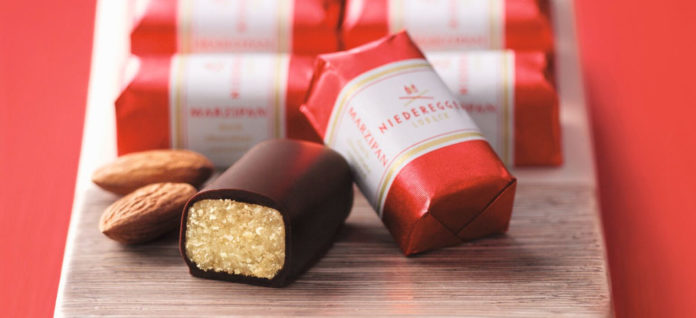Lübeck is not only famous for being the “Queen of the Hanseatic League”, it also carries the epithet of the “marzipan city” with pride.
Additionally, Why is Lubeck famous for marzipan? Lübeck, as the capital of the Hanseatic League, was an important trading hub, which insured a steady supply of ingredients. Consequently, in the 18th century, the marzipan produced in Lübeck started becoming well known for its high quality, due to its high almond content.
How is marzipan used in Germany? In Germany, it is common to give marzipan in the shape of a loaf of bread, Marzipanbrot, during Christmas time or shaped as small potatoes (Marzipankartoffeln). Stollen can contain marzipan, and it is often featured as an ingredient in seasonal baked goods, such as Bethmännchen and other Christmas cookies.
Subsequently, Which country eats the most marzipan? A quick visit to Lübeck in Germany, considered ‘marzipan capital of the world’. Generally associated with Christmas here in the UK, the marzipan trade flourishes all year round in Germany. In 2015, Germany was Europe’s largest food and beverage market – the third largest sector of German industry, overall.
FAQ
Which German city is famous for marzipan?
The German city of Lübeck is famous for its sweet confection, but visitors will develop a taste for its charming old town, good food and fine beer, writes Tom Lappin. Lübeck is an infinitely more refined place, so its culinary invention had to be more elegant.
Does marzipan have alcohol? No, it is purely ground almond paste — tastes delicious. NO alcohol….. !
Who invented marzipan? The invention of marzipan is usually attributed to Lübeck, Germany. Legend has it that during a 15th century famine when flour for making bread became scarce, the senate of Lübeck ordered bakers to create a replacement. Using eggs, sugar, and stores of almonds, the clever bakers came up with marzipan.
What country invented marzipan? The invention of marzipan is usually attributed to Lübeck, Germany. Legend has it that during a 15th century famine when flour for making bread became scarce, the senate of Lübeck ordered bakers to create a replacement. Using eggs, sugar, and stores of almonds, the clever bakers came up with marzipan.
What does marzipan smell like?
Marzipan is distinguished by its strong almond-like aroma and it is often used for chocolate fillings, cakes icing, as a cake ingredient, or it can be shaped into small figures.
What does marzipan mean in Spanish? Español. marzipan n. (sweet almond paste) mazapán nm. Exemplos: el televisor, un piso.
Where does the best marzipan come from?
Real-deal marzipan is still made the old-fashioned way in Lübeck, Germany, where an army of candy artisans is preparing for the holidays. Not many people know about Lübeck, the small German city that’s the sweet spot of all of Europe—literally. Lübeck’s been the world capital of marzipan for hundreds of years now.
What is marzipan city based on? Most of the buildings are influenced by Indian and Russian architecture, and Marzipan City is based on C.H. Greenblatt’s experiences in New York City, New York and Paris, France.
What is the shelf life of marzipan?
The marzipan will keep at room temperature in a dark, dry and cool place for up to 3 weeks.
What do you eat marzipan with?
Uses of marzipan
- Easter eggs – my favorite treat of all times – the classic or chocolate Easter eggs.
- Fruit Cakes – Traditionally fruitcakes are covered in almond paste and Royal Icing. …
- Top a Carrot cake. …
- Marzipan Layered cake – Roll and cut out a disc the same size as your cake.
What is marzipan called in America? What Is Marzipan? Also called almond candy dough, marzipan is an agreeable, multi-purpose combo of the first two, with a subtle almond flavor and unmatched malleability.
What is difference between marzipan and Frangipane? Frangipane is a variation of soft, spreadable custard that bakers commonly use as a filling in tarts, galettes, and puff pastries. Marzipan is a sweet almond paste used as a candy or fondant, adding texture to traditional cakes, like German stollen, or rolled out and used like fondant.
What language is marzipan?
Etymology. Borrowed from German Marzipan, from Italian marzapane, Venetian marzapane.
Why is it called marzipan? The word “marzipan” is derived from German Marzipan or Italian marzapane, most likely after St. Marcus; the Estonian name is martsipan. This product is an elastic paste made of grated, powdered almonds and powdered sugar.
What’s the difference between marzipan and Frangipane?
Frangipane is a variation of soft, spreadable custard that bakers commonly use as a filling in tarts, galettes, and puff pastries. Marzipan is a sweet almond paste used as a candy or fondant, adding texture to traditional cakes, like German stollen, or rolled out and used like fondant.
What is a poison that tastes like marzipan? Cyanide. Cyanide tastes like bitter almonds. It’s also the most deadly of all the poisons we know of, so if you’re tasting it or someone close to you is, please seek immediate medical attention.
What poison smells like marzipan?
Cyanide can be a colorless gas, such as hydrogen cyanide (HCN) or cyanogen chloride (CNCl), or a crystal form such as sodium cyanide (NaCN) or potassium cyanide (KCN). Cyanide sometimes is described as having a “bitter almond” smell, but it does not always give off an odor, and not everyone can detect this odor.
Can you eat marzipan? Can you eat raw marzipan? The traditional recipe does include raw egg whites, not yolks so there is no risk of salmonella. So unless you are allergic to eggs you can eat raw marzipan. Having said that all my recipes substitute the raw egg with sugar syrup or water so you can eat all my marzipan recipes raw.
Don’t forget to share this post !























